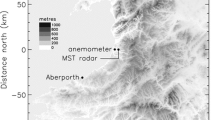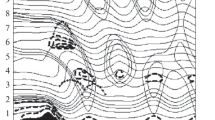Summary
Satellite pictures have been utilised to detect mountain waves on the lee of the Andes range. The wavelengths as observed in the pictures from the distribution of clouds in parallel bands lie between 20 and 30 km for the five cases examined. The wavelengths have also been computed theoretically for these cases by an analytical method and a quasi-numerical method, using linearised perturbation equations. Wavelengths so computed are in fairly good agreement with the observed wavelengths, Vertical velocities associated with the waves along the different sectors of the Andes have also been computed. Their maximum values are of the order of 1–5 m sec−1. Also, the quasi-stationary character of the waves, as noticed in some of the pictures, is discussed.
Similar content being viewed by others
References
A. Cohen andE. Doron,Mountain lee waves in the Middle East: theoretical calculations compared with satellite pictures, J. Appl. Meteor.6 (1967), 669–673.
J. H. Conover,The identification and significance of orographically induced clouds observed by TIROS satellites, J. App. Meteor.3 (1964), 226–234.
A. Corby andJ. S. Sawyer,The airflow over a ridge: the effects of the upper boundary and high level conditions, Quart. J. Roy. Meteor. Soc.84 (1958), 25–37.
U. S. De,Lee waves as evidenced by satellite cloud pictures, I. J. Met. Geophy.21, No. 4 (1970), 637–647.
B. R. Döös,A mountain wave theory including the effect of wind and stability, Tellus,13 (1961), 305–319.
B. R. Döös,A theoretical analysis of lee wave clouds observed by TIROS I, Tellus, (1962), 301–309.
S. Fritz,The significance of mountain lee waves as seen from satellite pictures, J. App. Meteor.4 (1965), 31–37.
T. N. Krishnamurti,The finite amplitude mountain wave problem with entropy as a vertical coordinate, Monthly Weather Review92, No. 4 (1964), 147–160.
J. P. Kuettner andD. K. Lilly,Lee waves in the Colorado Rockies, Weatherwise21, (1968), 180–196.
G. Onishi,A numerical method for three-dimensional mountain waves, J. Met. Soc. Japan47 (1969), 352–359.
E. Palm andA. Foldvik,Contribution to the theory of two-dimensional mountain waves, Geof. Publ.21, No. 6 (1960), 30 pp.
E. M. Pekelis,A numerical calculation of finite-amplitude orographic disturbances (the two-dimensional problem), Izv. Atm. Oceanic Phy.2 (1966), 1113–1125.
E. M. Pekelis,A numerical method of calculating lee waves with an arbitrary distribution of the basic flow parameters (two-dimensional linear problem), Izv. Atm. Oceanic Phy.5 (1969), 3–16.
P. Queney,Theory of perturbations in stratified currents with application to airflow over mountain barriers, (The Univ. Chicago Press, Misc. Rep. No. 23, 1947).
R. P. Sarker,A theoretical study of mountain waves on Western Ghats, I. J. Meteor. Geophy.16 (1965), 565–584.
R. P. Sarker,Some modifications in a dynamical model of orographic rainfall, Monthly Weather Review,95, No. 10 (1967), 673–684.
J. S. Sawyer,Numerical calculation of the displacements of a stratified airstream crossing a ridge of small height, Quart. J. Roy. Meteor. Soc.86 (1960), 326–345.
R. S. Scorer,Theory of waves in the lee of mountains, Quart. J. Roy. Meteor. Soc.75 (1949), 41–56.
I. Vergeiner andD. K. Lilly,The dynamic structure of lee wave flow as obtained from balloon and airplane observations, Monthly Weather Review98 (1970), 220–232.
I. Vergeiner,An operational linear lee wave model for arbitrary basic flow and two-dimensional topography, Quart. J. Roy. Meteor. Soc.97 (1971), 30–60.
Author information
Authors and Affiliations
Rights and permissions
About this article
Cite this article
Sarker, R.P., Calheiros, R.V. Theoretical analysis of lee waves over the Andes as seen by satellite pictures. PAGEOPH 112, 301–319 (1974). https://doi.org/10.1007/BF00876142
Received:
Issue Date:
DOI: https://doi.org/10.1007/BF00876142




